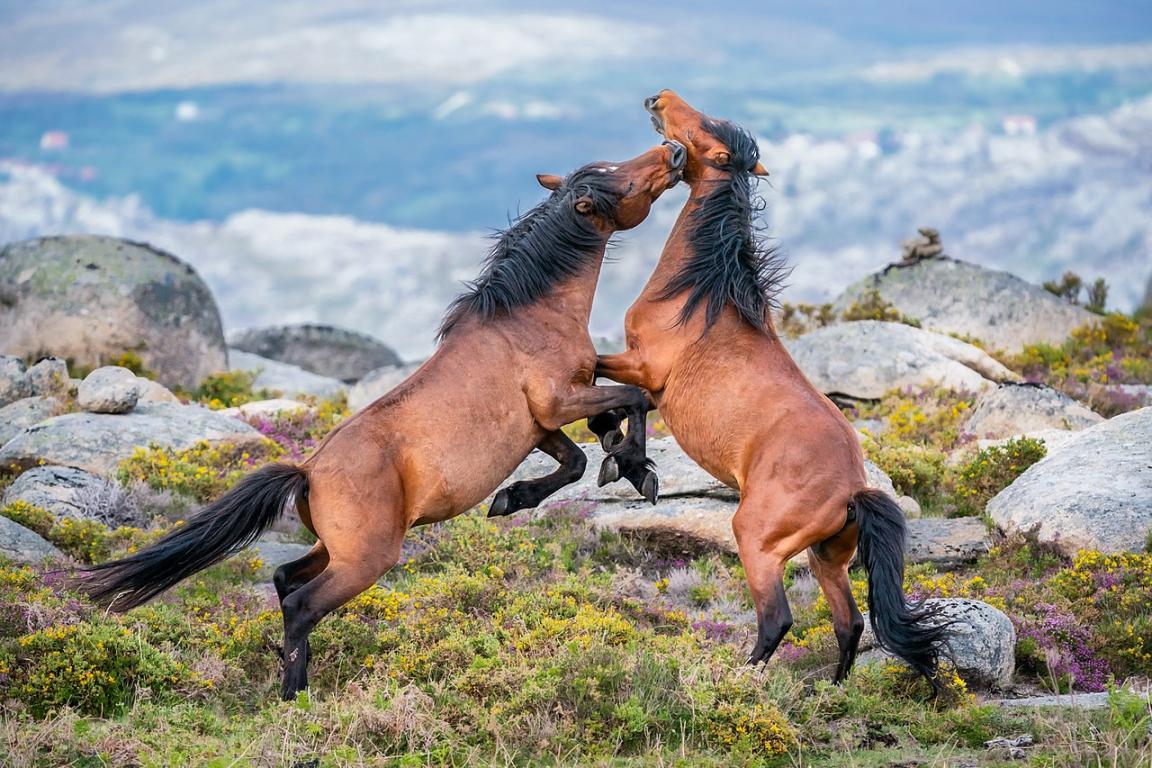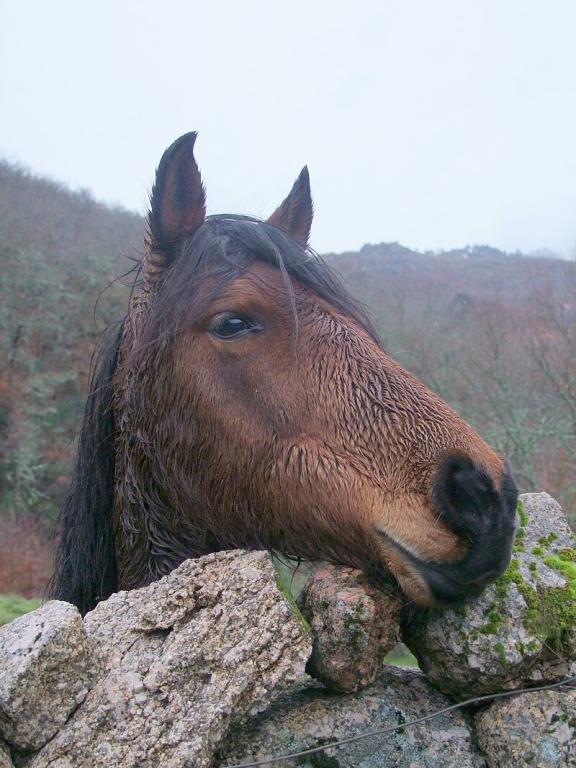
Continent: Europe
Country: Portugal
Weight: 250 – 300 kg
Height: 120 – 135 cm

The Garrano is a primitive pony from northern Portugal, mainly found in the Minho and Trás-os-Montes regions.
It is one of the oldest Iberian breeds, with traces dating back to prehistoric times.
It was long used by farmers for:
Today, it is also bred for biodiversity conservation and sometimes used for trekking.
The word “Garrano” comes from old Portuguese garrano/garrana, which referred to a small, rustic, common horse, often semi-wild.
These mountainous regions, with a humid Atlantic climate, provide natural pastures that allow the Garrano to live in semi-freedom.
Present in a few bordering areas of Galicia, where it shares its origin with the Caballo de Pura Raza Gallega. Some hybrid populations exist in mountain border zones, but the main conservation center remains Portuguese.
The Garrano is integrated into several environmental management programs:
Here, the Garrano is used as a natural grazer to prevent wildfires and maintain ecological balance.
A few private breeders exist today in other Portuguese regions, but they remain marginal. The Garrano is very rare outside the Iberian Peninsula: a few specimens are preserved in European genetic conservation programs (notably in France, Germany, and the Netherlands, often in primitive breed parks).
The Garrano is one of the oldest representatives of the prehistoric Iberian horse. Its morphological traits (small size, compact build, dark bay or black coat) strongly recall the horses depicted in Paleolithic rock art in Portugal’s Côa Valley.
It probably contributed to the development of more prestigious Iberian breeds such as the Lusitano and the Andalusian. It is genetically close to the Galician pony (Caballo de Pura Raza Gallega), with which it shares a common origin. Related to the Sorraia, another Portuguese primitive horse, although the Garrano has preserved a more massive, mountain-adapted build. Some DNA analyses show a link with ancient Celtic horse populations, reinforcing its status as a unique genetic reservoir.
As a rustic and native breed, the Garrano retains resistance genes (to disease, harsh climates, and food scarcity). Its adaptability and endurance make it a valuable resource for the genetic improvement of modern breeds, especially to strengthen hardiness, fertility, and longevity.
The Garrano is used in rewilding projects and in the sustainable management of northern Portuguese landscapes. Through grazing, it helps limit the spread of scrubland and thus reduces the risk of forest fires.
The FAO lists the Garrano among the equine breeds to be protected as it represents a rare genetic heritage. Safeguard and pure-breeding programs are supported by Portuguese authorities and local associations.
The Garrano is considered one of the oldest horses of the Iberian Peninsula. Rock art representations in the Côa Valley (Portugal), dated to the Upper Paleolithic, show horses very close to its type: small size, compact build, dark coat.
A probable direct descendant of primitive Iberian horses, it remained isolated in the northern Portuguese mountains, preserving its type. During Antiquity, it was used as a pack pony and light mount by the Callaeci and Lusitanian peoples.
Roman authors mention small, robust horses in the northwest of Hispania, very similar to today’s Garrano.
The Garrano served as light war horses, valued for their agility in mountainous terrain. They participated in the cavalry of northern Christian kingdoms during the Reconquista. Their hardiness made them indispensable to mountain farmers for transport and agriculture. Occasional crossbreeding occurred (with Andalusians, Arabs, Berbers), but without erasing the original type.
The Garrano remained a versatile rural horse:
In some regions, it served as a foundation for improving other Iberian breeds (notably the Lusitano and Galician horses). Its role gradually declined with the arrival of larger, more powerful horses and changes in farming practices.
Agricultural mechanization caused a dramatic decline. In the 1940s–1960s, the breed nearly became extinct. A few populations survived in semi-freedom in the Minho and Trás-os-Montes mountains.
In the 1970s, an official stud-book was opened and safeguard programs launched. The Garrano was recognized as a heritage breed, integrated into biodiversity conservation policies.
Today, the Garrano is mainly raised in semi-freedom in the northern Portuguese natural parks (Peneda-Gerês, Barroso, Montesinho). It plays a major ecological role in wildfire prevention through extensive grazing.
The breed is also promoted in rural and cultural tourism (trekking, traditional festivals, leisure riding). Despite its rarity, the Garrano enjoys growing recognition in Portugal and Europe as a genetic and cultural treasure.
Accustomed to living in semi-freedom in northern Portugal’s mountains, the Garrano is an extremely hardy horse.
Social behavior
Historically used by farmers and shepherds, it developed a pragmatic relationship of trust. Today, it is valued for children’s riding, light harness work, and sometimes equine therapy, thanks to its gentle temperament.
The Garrano is a robust, intelligent, docile, and reliable horse, adapted to both semi-wild life and modern leisure/eco-tourism uses.
Despite a small population (a few thousand individuals, many in semi-freedom), the Garrano now benefits from protection programs supported by the Portuguese State and the European Union. Maintaining the official stud-book and raising awareness among local breeders are essential to avoid genetic dilution through uncontrolled crossbreeding.
The Garrano is increasingly used as a landscape management tool:
This ecological function, supported by public policies, ensures the breed a lasting role in rural economies.
The Garrano represents an identity symbol of northern Portugal:
It attracts visitors interested in ecotourism, contributing to the vitality of rural areas.
Although small, the Garrano remains a versatile pony:
Its docile and hardy temperament makes it suitable for leisure riding and educational equestrian activities.
Its ancient genetic heritage makes it a valuable resource for research (studies of equine phylogeny, links with prehistoric Iberian horses). It could serve as a genetic reservoir to reinforce the hardiness of other threatened or overly specialized breeds.
The Garrano is no longer just a “mountain pony”: it is moving towards a triple valorization – ecological, cultural, and patrimonial – that should ensure its long-term survival.
The Garrano is a very resilient breed thanks to its millennia-long adaptation to northern Portugal’s mountains.
The Garrano is a naturally healthy horse, rarely affected by disease, but requires careful genetic management and an adapted diet when raised outside its mountain habitat.